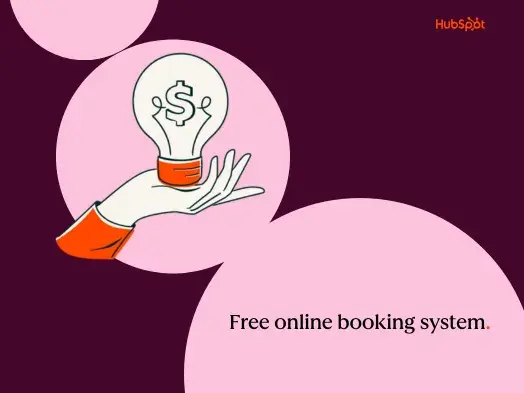Reps make countless calls each day, hoping and praying that one of their prospects will pick up the phone. And when someone finally does, what do they say?
"I'm too busy for this."
"Can you just send some information?"
"Is this a sales call?" *Click.*
You don't even get the chance to pull out your attention-grabbing statistic or perfectly phrased value proposition before the call ends. And you find yourself back at square one.
If salespeople can even slightly boost their odds of booking that critical first meeting, their pipelines will be in good shape. At an AA-ISP's Inside Sales Leadership Summit, Mike Scher, CEO of Frontline Selling, shared a three-step process proven to increase the chances of booking an appointment.
"We looked at different reps and the ones that were most effective did three very simple things every time they had a key player on the phone," Scher says. "Those three steps are called disarm, purpose, and question."
1. Disarm: Get them to lower their guard.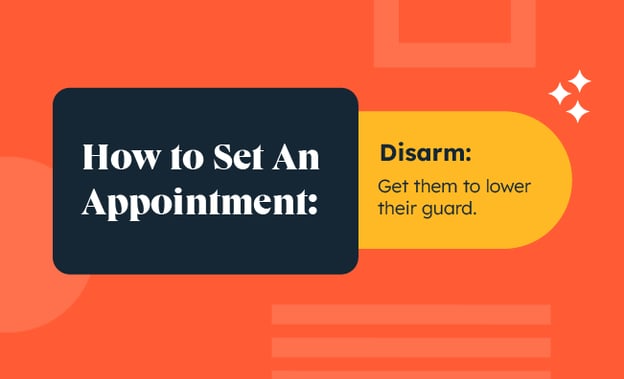
On the off chance a buyer actually answers the phone, one thing is certain—they're busy. With this in mind, Scher says that reps with the highest connection rates acknowledge this fact up front.
He suggests "introducing yourself and your company and acknowledging they're busy,"
For example: "Hi, this is Ann Jones with ABC company. I'm sure I caught you in the middle of something.”
Why introduce yourself? Scher points out that people are naturally suspicious when they pick up the phone, and the best way to get them to lower their guard is by saying outright who you are and where you're calling from.
"Disarming them gets their attention off whatever else they're doing and gets them focused on you," Scher says.
2. Purpose: Explain why you are calling.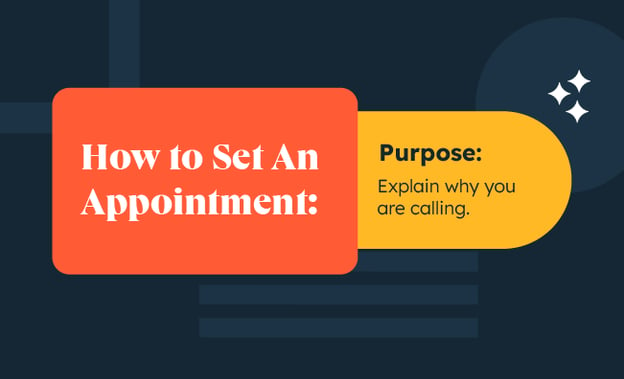
Every sales rep knows the point of a first call is to set up an appointment. But according to Scher, "the number [of reps] that actually ask for an appointment is very small."
After disarming the prospect, Scher advises reps to dive straight into their purpose — asking for a meeting. For instance, reps might say something like, “The purpose of this call is to get 20 to 30 minutes to discuss how we can reduce your operating costs by 20%.”
Why 20 or 30 minutes? Scher explains that this block of time was deliberately chosen.
"When you ask for less than a 20 or 30-minute block you're doing yourself a disservice," he says, "Lots of times, people ask for five or 10 minutes — all you're doing is indicating it's not important."
3. Question: End with a specific question on how to accomplish your purpose.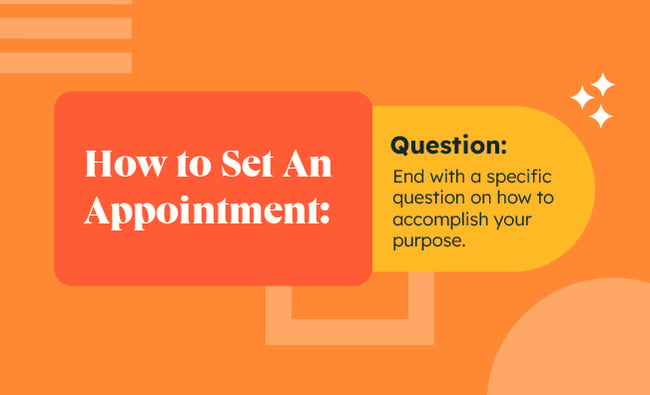
Scher advises reps to end their prepared speech with a specific question.
"Ask a question on how to accomplish your purpose — like, 'Would Tuesday at 10 or Wednesday at 2 work best for such a call?' If we ask the question, they have to answer it."
Unless, they don't. During Scher's presentation, an audience member brought up the fact that a prospect might ignore the question entirely and ask, "What is this about, anyway?" In this case, Scher recommends a rinse and repeat—disarming, stating the purpose, and asking a question all over again.
If the prospect still evades an appointment after three cycles of this process, Scher suggested sending a piece of informational content in a calendar invite.
"The obligation for them to read the materials will never be higher than at [that moment], so use that opportunity to lock down the appointment," Scher says.
How to Ask for an Appointment Over the Phone
If you're speaking to the prospect on the phone, there are additional tips you can use to book an appointment with them.
1. Understand their level of interest.
During your initial call with the prospect, communicate the purpose of the meeting you'd like to book with them. Will your solution give them the benefit of lower costs, more revenue, or gains in efficiency?
Listen for their interest level once you communicate the purpose of the meeting. If they're skeptical, carry on with the conversation, but don't push too hard for an appointment. Instead ask, "Would you be interested in having an initial conversation about [solution/benefit]?"
If the prospect is interested in your solution, move the conversation forward with questions like, "I'd love to have an initial conversation with you about [solution/benefit]?. What's the best way to book time on your calendar?" or, "When's a good time to discuss [solution/benefit] in more detail?"
2. Communicate the value of the appointment.
What does the prospect have to gain from meeting with you? Instead of focusing on selling your product, let them know the value the meeting will provide for them. Whether you can help them solve a problem or offer advice, let them know what they'd get in return from the meeting.
3. Give them a choice.
Providing the prospect with a choice of meeting times keeps them engaged in the conversation. Ask them, "We can meet this Wednesday at 2:00 PM. Or does next Monday at 3:00 PM work better with your schedule?"
Move the conversation forward by avoiding "yes or no" questions. By giving them options, they'll have to make a choice — and by suggesting different meeting times, that choice will likely lead to an appointment.
How to Ask for a Meeting by Email
On the other hand, email is the preferred method of communication for prospects who prefer asynchronous communication.
1. Build rapport.
Don't start the email with your ask. That would be rude over the phone or in person, and it's just as rude over email. Instead, start by asking your prospect how their day is going and what they're focusing on this week, or include a personalized comment about the weather or an event happening in their area.
For example, "Hello Ellie, Hope you're having a great week. I hear Denver is hosting the Great American Beer Fest this weekend. Will you be dropping by?"
This rapport breaks the ice, humanizes the conversation, and can earn you their attention for a few more seconds.
2. Keep it short.
Don't include the history of your company or your time with the company in this email. If you must, share that when you get in front of them in a pitch or finally get them on the phone. Instead, keep your email brief — no more than three to four paragraphs — and focused on the prospect and their needs.
3. Always include a close
Always have a goal for each time you communicate with your prospect. It should be the thing you close with in your email. This ensures your reader is primed to take action and you haven't wasted their attention.
For example, you may end your email by saying, "I'd love to earn 15 minutes of your time to learn more about your team's goals in Q1 of 2020. If you're interested, book time on my calendar here: [Insert Meetings link]"
Here's what that all might look like in practice:
Hello Zach,
How's your week going? I saw it's been surprisingly warm out in San Francisco so far this month. Have you had an opportunity to get to Baker Beach or Golden Gate Park? Regardless, I hope you've had a chance to make the most of the good weather.
I was taking a look at your marketing collateral and noticed your company hasn't really pursued any co-marketing partnerships. Your tech is obviously cutting edge — I think it could be the industry standard for higher-ed curriculum and schedule planning — but you're selling yourself short by staying siloed in terms of partner marketing.
I'd love to earn 20 minutes of your time to talk more about whether you intend to pursue co-marketing partnerships and the resources you might use to do so. If you're interested, book some time on my calendar here: [Insert Meetings Link]
Best,
Sunny
Tips for Booking an Appointment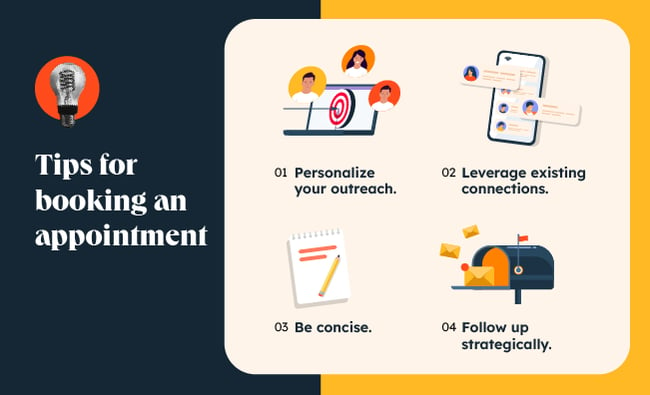
1. Personalize your outreach.
Personalizing your outreach means tailoring your message to the recipient's specific interests or needs. Doing this makes it clear to the prospect that you've done your research and have made the initial investment into helping them solve their biggest problems.
2. Leverage existing connections.
Leveraging existing connections can be a powerful way to reach new people or make introductions. Tap into your network and see if anyone can provide a warm introduction or vouch for your credibility. This can increase your likelihood of getting a response.
3. Be concise.
Everyone is busy and has something else they could be doing other than reading your email and responding to it. Get to the point quickly and highlight the most important information or benefits. Avoid unnecessary jargon or overly lengthy explanations.
4. Follow up strategically.
Following up strategically is essential to ensure your message doesn't get lost or forgotten. Be mindful of the recipient's preferred communication channel and follow up in a timely manner. Consider using tools like reminders or automated follow-up sequences to stay organized and consistent in your outreach.
With these steps and tips, you'll be able to book a meeting with anyone.
Editor's note: This post was originally published April 28, 2015 and has been updated for comprehensiveness.
This article was written by a human, but our team uses AI in our editorial process. Check out our full disclosure to learn more about how we use AI.




![How to find a meeting time that works for everyone [+ tools]](https://53.fs1.hubspotusercontent-na1.net/hubfs/53/Operation-everest-how-to-find-a-meeting-time-that-works-1-20250924-5040800.webp)

